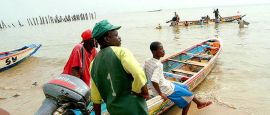Getting around Senegal
Air Senegal (https://flyairsenegal.com) offers domestic flights linking Dakar to Cap Skirring and Ziguinchor. The flight times are around 45 minutes. Cap Skirring is the gateway to the beautiful stretches of golden sands on the coast.
There are a number of local transport options depending on your budget and comfort requirements. It's also possible to rent vehicles from car hire companies but beware, you need to exercise caution when driving in Senegal as traffic can be chaotic.
Asphalt roads link the major towns and the coastal region but it's not advisable to drive at night as the roads may not be well-lit. The network of roads in the interior is rough and may become impassable during the rainy season.
There are often police checkpoints at the entrance and exit to villages to enforce speed restrictions; fines are paid on the spot.
There are five road classification categories in Senegal: national roads, regional roads, departmental roads, urban ways and classified tracks.
The capital, Dakar, is the endpoint of three routes in the Trans-African Highway network. The three routes are Cairo (Egypt) to Dakar, N’Djamena (Chad) to Dakar, and Lagos (Nigeria) to Dakar.
National roads are the most important roads in Senegal and are classed by numbers from 1 to 7. National roads are prefixed with the letter 'N', regional roads are prefixed 'R', departmental roads being 'D', urban ways being 'VU' and classified tracks being 'P'.
You can find hire car companies such as Hertz (tel: +221 33 8201 174;www.hertz.com) and Europcar (tel: +221 33 8650 812;www.europcar.com) in Dakar and the main towns. Pick-up points are available at Dakar Airport and at several depots throughout the city.
Taxis are available in most towns and fares are metered. Rates increase after midnight. It's cheaper to hail a taxi on the street than arrange to be collected from the hotel. Taxi prices are theoretically fixed. However, standard practice is to bargain with the driver through the passenger window. To get the best price, you need to refuse the driver's final offer and continue to negotiate. Be ready to have small bills and coins to pay for the fare.
For journeys between towns, shared sept-place (seven-seat) taxis are common but the journey can be uncomfortable as you are crammed into a battered car with others. Minibuses (Ndiaga Ndiaye) are a more comfortable alternative.
Bicycle hire is available in certain smaller towns around Senegal and is a great way to explore the town and the surrounding countryside. Your best bet to find bicycles is in beach resort towns such as Saly Portudal or Cap Skirring, or in places where community-based tourism projects have been implemented such as Kedougou or Tambacounda. It's not advisable to hire a bike in the hustle and bustle of Dakar.
Unlike a lot of West African countries to the south of Senegal, there are fewer motorbikes present on the streets. However, in Dakar, you can rent scooters or small motorbikes.
Make sure you bring your own helmet and other safety gear. Senegal can be muddy during the rainy season, and dry and dusty the rest of the year.
There are minibuses and long-distance coach services between towns but the service may not be frequent, as most people rely on sept-place (seven-seat) taxis.
In villages and towns, the speed limit is 50kph (31mph). Outside of towns the limit is 90kph (56mph).
If you are driving, it is imperative to have a valid driving licence or International Driving Permit. You can convert your national driving licence to a Senegalese licence at the Ministry of Transport's Land Transport Department.
It's useful to carry a copy of your passport to show officials, as they usually ask for it at check points. Beware that there may be officials asking for a bribe.
There are no breakdown service companies in Senegal but there are mechanics in towns and cities.
If you are renting a car, it's advisable to ask what the options are for breakdown cover from the car hire company you are using. They will probably give you a number to call and will most definitely have their own breakdown service.
A national driving licence or International Driving Permit. If you are driving a car which isn't registered in Senegal, then a Green Card (a document proving that you have adequate insurance to drive abroad) is required.
Roads in Senegal are of mixed quality. In and between major towns, roads are asphalted. Smaller roads are usually in poor condition and they get muddy during the rainy seasons.
Bus and minibus services operate in Dakar. Blue public buses come every 30 to 60 minutes during the daytime. Smaller white public buses come more often but these buses do not stop at many places.
The colourful blue and yellow car rapide is one of Senegal's iconic symbols. Each one is painted differently and many state 'ALHAMDULILLAH' (Praise be to God) across their fronts.
A ferry line runs from Dakar to Ziguinchor, arriving the morning after departure. Sea shuttles depart regularly from Dakar to Île de Gorée. There are also pirogues (boats), linking Dakar and Île de N'Gor, a small island just off Dakar's north shore.
Do you have any Feedback about this page?
© 2025 Columbus Travel Media Ltd. All rights reserved. No part of this site may be reproduced without our written permission, click here for information on Columbus Content Solutions.




 You know where
You know where